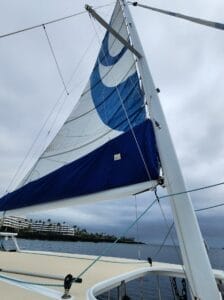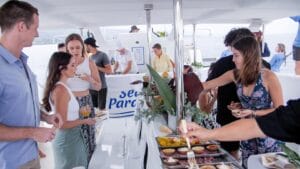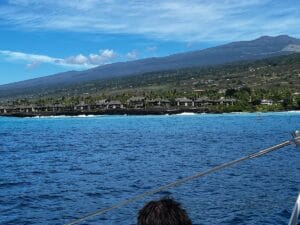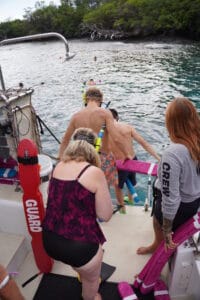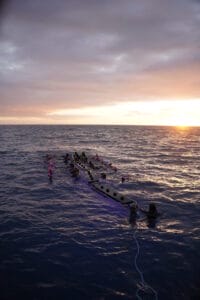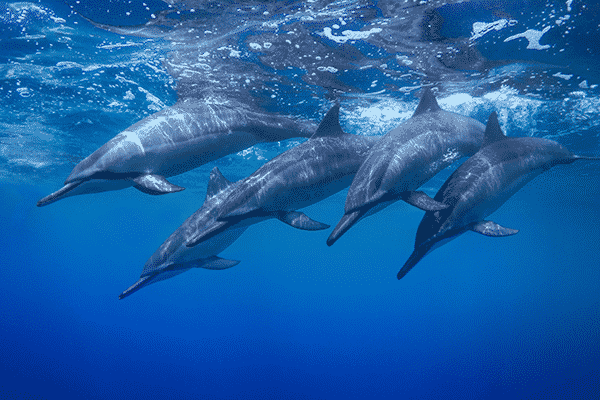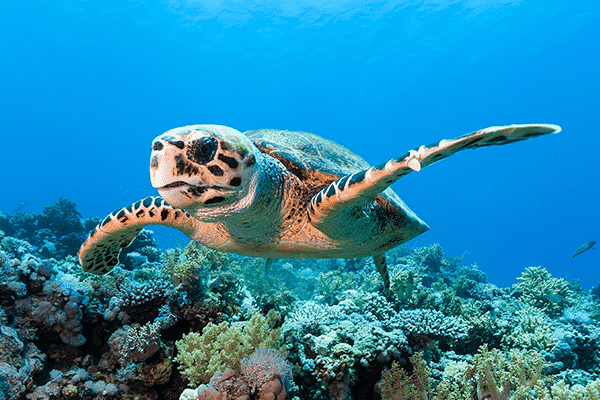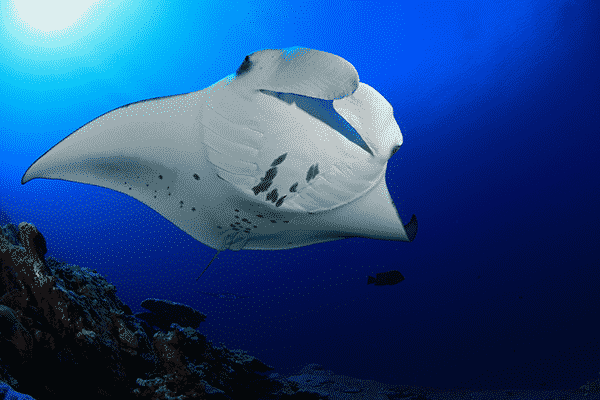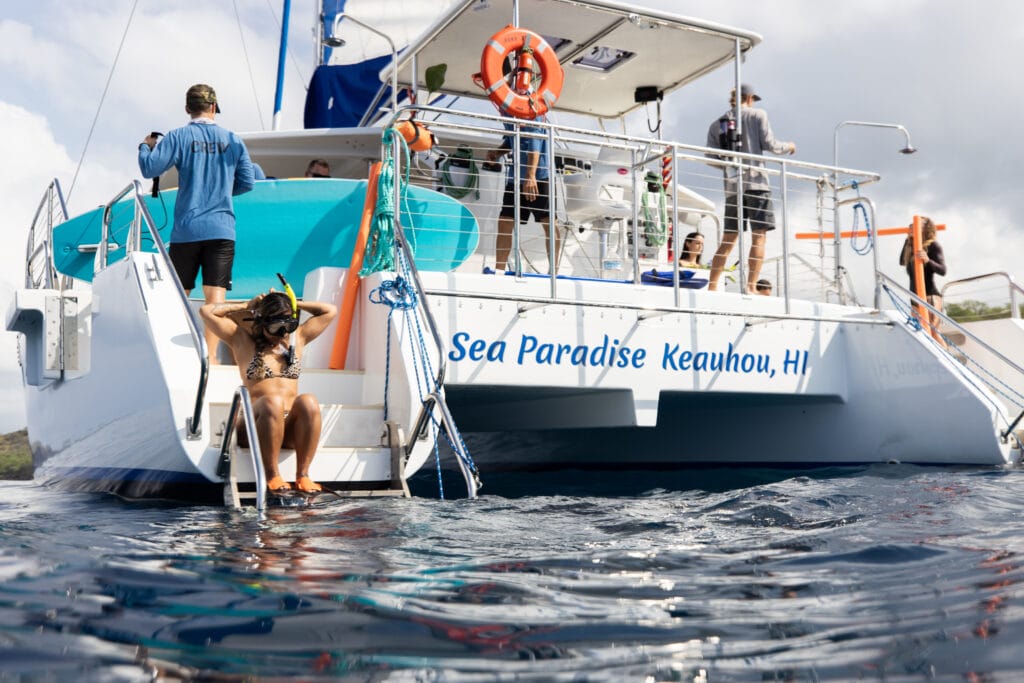1. Night Snorkel with Manta Rays
Imagine floating in the water, the lights below you attracting the plankton, and next thing you know giant, gentle Manta rays are swirling all around you, gliding through the water. It’s a magical experience! The Manta swim takes place after dark, so it’s easy to have a long, relaxing afternoon on the beach in Kona prior. Manta snorkeling boats will attach lights to the bottom of flotation devices, which attract the plankton that the mantas eat. All required gear is provided for you.2. Captain Cook Memorial and Kealakekua Bay
The suggestion is really not for the memorial itself, but the Kealakekua Bay – aka some of the best snorkeling on the Big Island of Hawaii. Getting to the bay requires some tenacity – you can hike a good hour+ each way, rent a kayak (try Kona Boys in Captain Cook or drive to Manini beach and rent there), or take a snorkeling tour that will bring you directly there.I chose to hike down and loved the trail and the snorkeling. Be forewarned there’s no drinking water, parking fills up very early at the trailhead (even before 9am on busy days), and you’re looking at about 4 miles roundtrip with a 1300 foot elevation gain. While I do not agree with many of the reviewers who say it’s a ‘difficult’ hike, it is hot, unshaded for most of it, and there are no flat parts. If you hike regularly you’ll probably enjoy it, but I passed many hikers on the way up who were struggling.
When you visit, please remember to wear only reef-safe sunscreen, don’t put on DEET before going in the water as it’s terrible for the coral, and absolutely don’t stand after entering. There were so many people standing to adjust their masks, but that kills the coral and there are tons of animals in the water they were likely crushing, even immediately after entering. It’s just as easy to float and make any adjustments. If you struggle to swim, bring a pool noodle to help.
3. Two Step
For those who fancy more accessible snorkeling, drive to Two Step. There is limited parking right in front of the tide pools, or a paid parking lot, which costs five dollars. Early morning is the best time to spot dolphins, though please respect the distancing rules as the morning is their sleeping time. The reef and abundance of fish are fantastic as well. Please wear reef-safe sunscreen! Yo, it’s important to mention that currents and water on the Big Island can change quickly. Water can be rough, and people drown all around the island each year. It’s important that you refrain from going in the water if you have any doubts whatsoever. That goes for every beach on this list.4. Pu’uhonua O Hōnaunau National Historical Park
Just a stone’s throw from Two Step, this historic park has plenty of exhibits that take you through Hawaiian culture and history. It’s easy to self-navigate and takes about an hour to walk through the exhibits. Bring your National Parks Annual Pass for free entry. You can also book a snorkeling tour that includes a stop at Pu’uhonua O Honaunau.5. South Point Cliff Jump and Snorkeling
I loved this spot so much that I went back twice! Taking the South Point Road that most people take to go to the Papakōlea Green Sand Beach, instead of making a left where you see the painted car door that says ‘green beach’, continue straight all the way to the end of the paved road. Please do not continue beyond it, even if you see other people doing it, as there are historic artifacts and endemic plants that are trying to grow back. This area is famous for two things: a fairly tall cliff jump, and a giant ball of thousands of glittering fish for those who love free diving like I do. If you want to get into the water without jumping, head to the right of the cliff jump, and you will see some rocks that are climbable. There’s also a cave that you can swim up to, provided that the water is calm and nobody is jumping in at the same time (that said, please don’t jump into the cave, it’s likely to end in tears).Keep in mind that the current is very strong once you swim away from the cliffs, so be vigilant and only go in if the water looks good! It’s best to go on a weekday as during the weekends there are lots of fishermen and therefore hooks in the water.
On a great day, though, it really is great. Not many tourists know about it, and the bait ball attracts some bigger fish as well. Keep an eye out for sharks, though.
6. Papakōlea Green Sand Beach
Papakōlea Green Sand Beach is hailed as one of only 4 in the world with green sand. Don’t expect to see a forest green beach — it’s more of a brownish hue — but it is pretty crazy to hold up the little grains and see that they are, indeed, green in color. The rare sand was created by the cinder cone next to the beach which was formed during an eruption almost 50,000 years ago. To get there, you can either walk for about an hour along the coast – bring sunscreen – or you can take a high clearance, 4×4 vehicle. I love my Hawaiian 4×4 adventures, but after making it halfway through, I decided to turn back because the road was truly terrible (a self-drive audio guide may have been able to make things better!). In a rental car, I was too worried about causing issues I’d have to sort through with insurance later. That said, you can hire a local for about 20 bucks to pile you in a pickup truck and transport you, or just walk. I’d aim for the afternoon to avoid the heat. The sand looks best during golden hour, anyway. There will be fewer tourists around, too.7. The Punalu’u Bake Shop: The Southernmost Bakery in the USA
Let’s be honest, this is a bit of a tourist trap, but if you are a big fan of Hawaiian sweet bread you might as well stop by for some donuts.8. Aloha Mix
There’s slim pickings for food if you’re making your way over to Hawaii Volcanoes NP or Punalu’u Black Sand Beach from Kona, and it’s a long drive. The food truck across the way from the bakery has acai bowls as well as grilled steak and shrimp plates. It’s delicious! PLEASE: Bring your own cutlery or just use your hands if you eat here. They’ll give you a plastic fork and spoon and Hawaii no longer recycles plastic. Please urge them to stop using plastic as well!9. Punalu’u Black Sand Beach
This was one of my more interesting snorkeling experiences, watching as the water got blurry while the tides mixed. It was a mix of cold and lukewarm water with lots of colorful fish, and of course, turtles.You will find that the areas where the turtles are resting are mostly roped off. Hawaiian green sea turtles are endangered and protected, so please don’t be one of those guys who sticks the camera in the turtle’s face to get a selfie, or worse, touches one trying to hitch a ride.
But you’d never even think of doing that, would you?
10. Buy some Macadamias
This part of the island has loads of farms that produce coffee, macadamia nuts, and even chocolate. You’ll see roadside advertisements from small, local farmers to stop in and try their offerings. This is how I ended up spending $35 on a small bag of coffee. I have no regrets, though – it tastes like honey coffee. How do they do it!?11. Hawaii Volcanoes National Park
The national park is one of the best places to visit on the Big Island for hiking, views, and otherworldly landscapes. As of the time of this writing, Kīlauea Volcano is erupting. Lava activity is confined to Halemaʻumaʻu with lava erupting from a vent on the northwest side of the crater. Things are every-changing, and you never know what the volcano goddess Pele might have in store! These are some of the best things to see there:- Hōlei Sea Arch: On your way down Chain of Craters Road, there are plenty of lookouts where you can see sweeping views all the way up the coastline as you make your way to the sea arch. It would be a great spot for sunset.
- Nāhuku – Thurston Lava Tube: A super cool lava tunnel – not for the claustrophobic! At the time of this writing, this is closed but they are working on re-opening it.
- Kīlauea Iki Trail: This is the most popular trail in the park and for good reason. You walk along the crater rim before descending down into it, walking across what feels like a moon landscape. If you have a clear sky, this is an excellent place to stargaze.
12. Catch Sunset at the Steam Vents
The sulfur banks and steam vents are an easy loop right from the Kīlauea Visitor Center. The whole walk is about 2 miles, give or take, depending on what you add in and cut out, and is a great spot to catch the sunset. Get there a bit earlier, at golden hour, and watch as the sun lights up the steam vents.13. Stay in a Treehouse
The volcano area of the Big Island is the spot if you’re looking for unique accommodation in a lush rainforest. Picture ferns, jungle, and bird sounds. This is my favorite place to stay on the island for nature and the proximity to the national park. Plus, it’s the only spot on the island with a bunch of cool treehouses to choose from.14. Kehena Black Sand Beach
Hawaii’s Puna district is in a word, strange. There’s something to be said about choosing to live in a place that could be engulfed by lava at any moment. This is the most volcanically active part of the Big Island, and also the funkiest. But as much as I love the hippy vibe, I can’t shake the menacing undercurrent. That said, if you’re feeling open-minded, this beach is Puna in a nutshell. On Sundays, there’s a drum circle, although on any day of the week you’ll see mostly locals hanging out there with their dogs, family members, weed dealers, and even kiddos.Keep in mind that this is a nude beach, so plan on at least half of the people being naked, especially at the Sunday drum circles. Personally I love the freedom of this, but I know it’s not for everyone!
Swimming can be great here, but the surf can also be very rough. If you don’t see anyone in the water, maybe you shouldn’t go in either.
15. Pepeekeo Scenic Drive
Heading north from the beach, enjoy one of the Big Island’s most beautiful drives. You’ll see beachside mansions, evidence of a recent lava flow that took out quite a few of them, as well as rows of enchanting tree tunnels. If you must be irresponsible and stand in the middle of the road like me, make sure you don’t have any blind spots and have plenty of time to move when cars drive by! Given the 2018 lava flow, this road isn’t a loop anymore, so you’ll need to turn back and retrace your steps somewhat. It’s still worth it!16. Hang in Hilo
As you drive through the Big Island of Hawaii, it’ll become evident that not only do the microclimates change constantly, but also the vibe and the neighborhood. Hilo will have a more local feel than Kona, and that’s what I love about it. It’s also much more lush and jungely. There are a few places to snorkel here as well, including Richardson Beach Park and Keaukaha Beach Park, but if you’ve enjoyed Two Step and the dolphins, you might not be impressed. Food and restaurants are great, though. I particularly liked the vegan food at Vibe, poke at Suisan Fish Market, and Makani’s Magic Pineapple Shack for funky flavors.17. Rainbow Falls and Boiling Pots
From Hilo, you don’t have to go far to reach Rainbow Falls and surrounding attractions. Depending on the water level you might be tempted to jump into the Boiling Pots as well, but would not advise it. Get ready, because this is the introduction to a very lush, waterfall-rich part of the island.
18. Onomea Bay Trail
This one is best reached early, since there is severely limited parking along the road at the trailhead, or you can pay to park at the Hawaii Tropical Botanical Gardens, which gives you access to their trail, which connects with the Onomea Bay Trail. It might be worth it, considering the Onomea Bay Trail is pretty short, though it does end with a beautiful viewpoint.19. Akaka Falls
Perhaps the most famous and accessible waterfall on Hawaii’s northeast coast, Akaka Falls is truly stunning. It’s a short, easy walk from the parking lot, past large banyan trees and a couple of other, less amazing falls. This place is popular. I got there right when it opened at 8 AM and was able to enjoy it and have it all to myself for a little while, though. Parking is five dollars.20. Mauna Loa
Since Mauna Kea is a sensitive area, for those wishing for some stargazing, Mauna Loa might fit the bill. You can’t drive all the way to the peak, though you can park at the observatory and walk. Keep in mind this is one hell of a hike. Though mostly flat, it is long, exposed, and at altitude, and you probably will have just come from sea level. If this sounds like too much to you, you can take a helicopter tour and fly over it instead.
That said, just from the observatory you can also get some great stargazing. Keep in mind that this is not an astronomical observatory, but rather an atmospheric research observatory, so tours might not be that exciting.21. Mauna Kea
Believe it or not, the Mauna Kea volcano frequently has snow on the top! Given the tropical inversion that exists below this mountain peak (inversion keeps clouds, moisture, and air pollution down below so up at the summit, it is very dry and clear most of the time) and lack of light pollution, Mauna Kea is heralded as one of the best places on Earth for stargazing, according to people who measure such things. That has also made it a target of much controversy. For Hawaiians, this is a sacred mountain and home to the snow goddess, and recent protests closed the summit for months (it has since reopened) as a battle wages over whether a 30-meter telescope will be built there or not. My vision of a better world is when our indigenous people have more rights, and I encourage anyone who visits the volcano to do so with the upmost respect and consideration of the locals. As the locals on Molokai shared with me, it’s not about no tourists, but about the right tourists, enjoying these beautiful areas.All of that said, there are multi-day hiking trails that go all along the area and, provided you practice Leave No Trace principles, I hope you get a chance to enjoy them. There are also star gazing tours that can take you to the top, as it’s inaccessible without a 4-wheel-drive vehicle.


